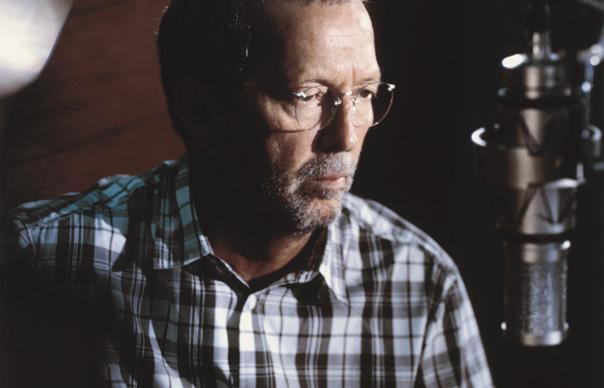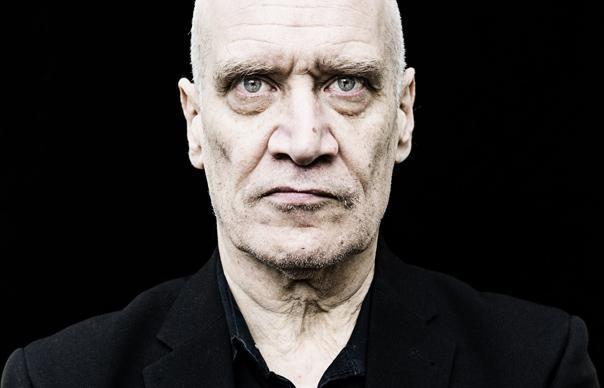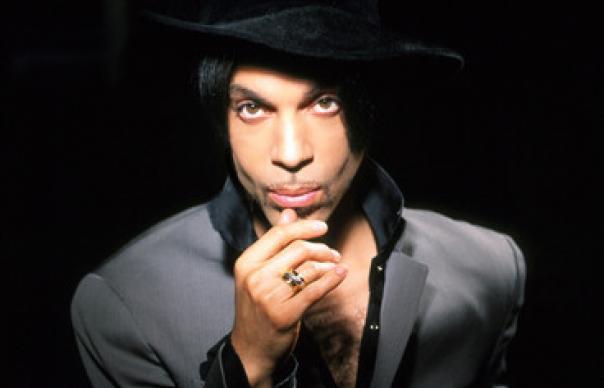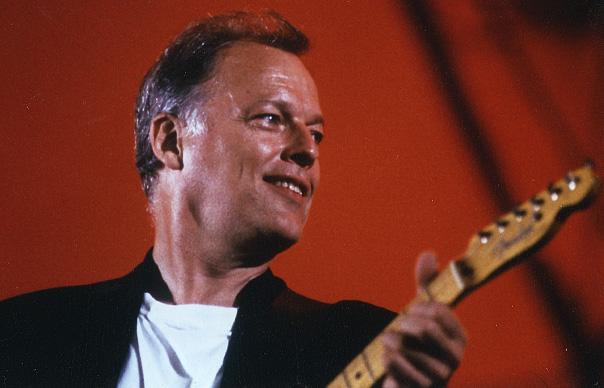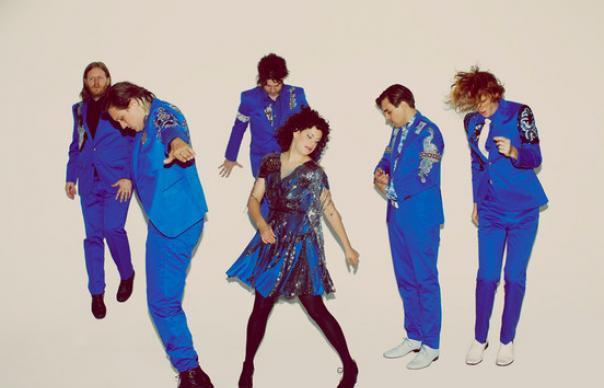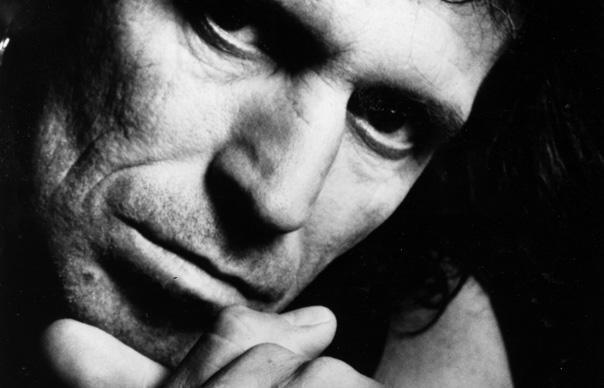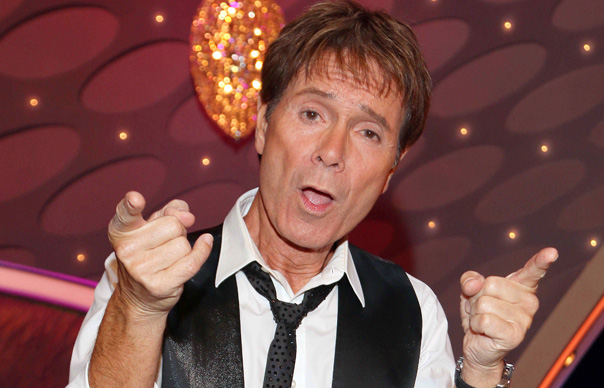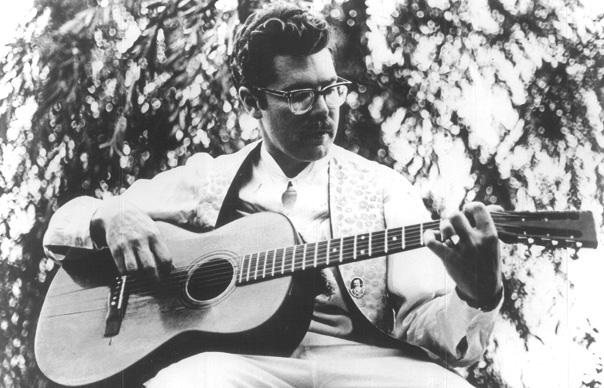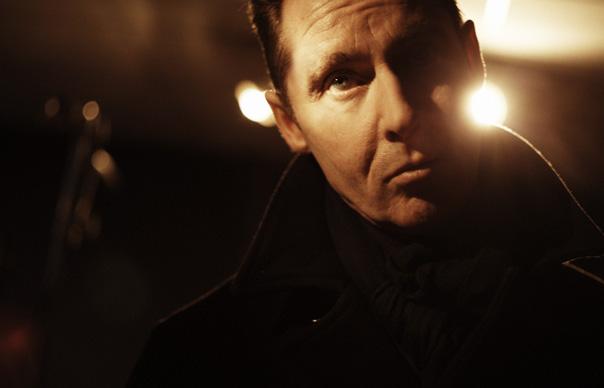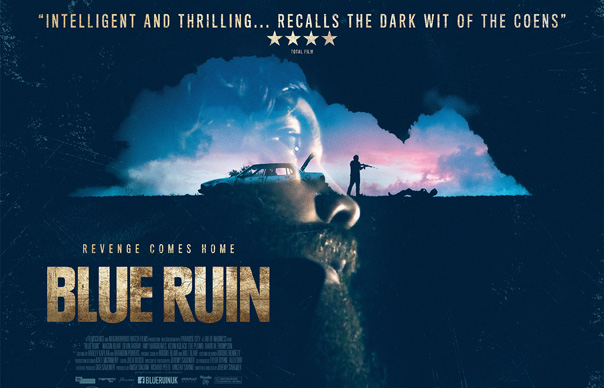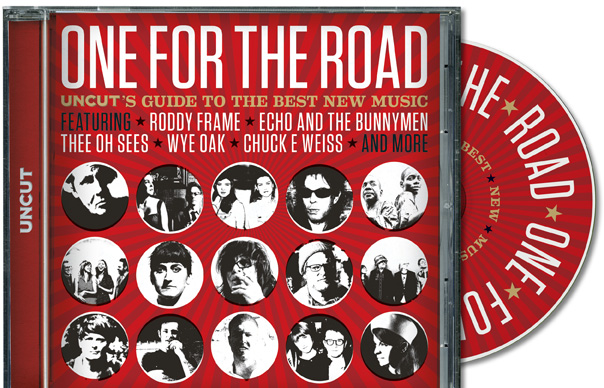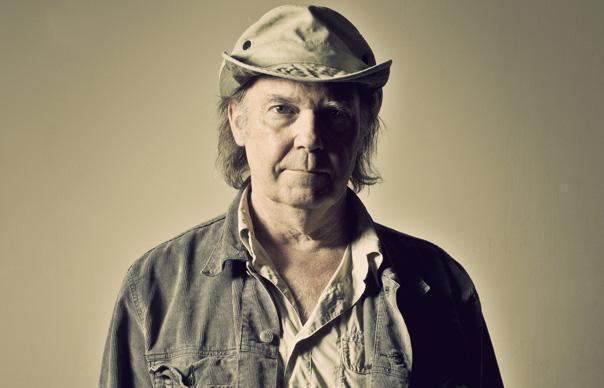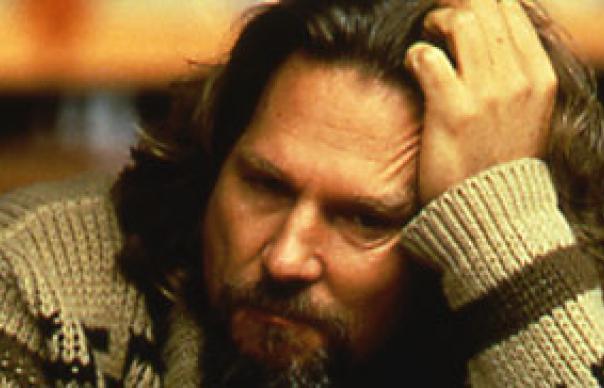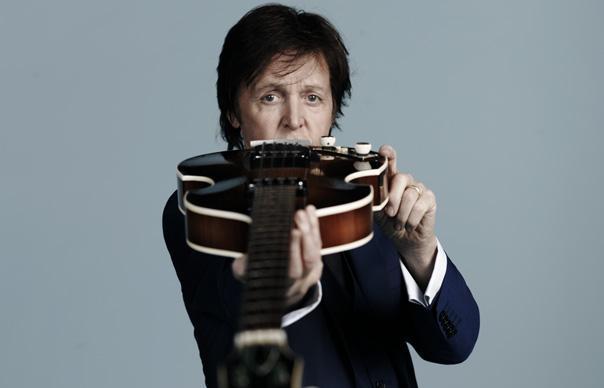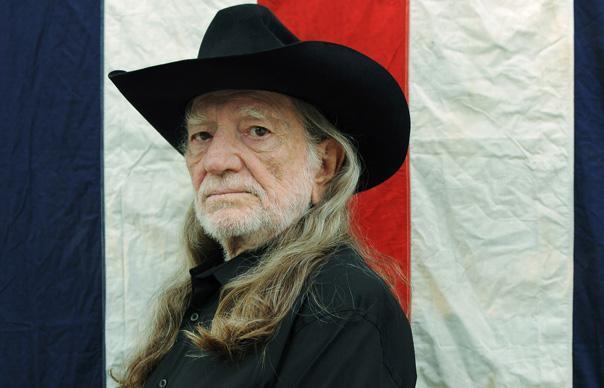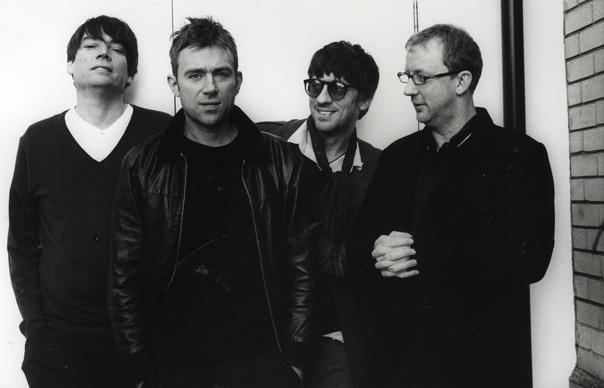As Damon Albarn prepares to release his debut solo album, Everyday Robots, on Monday, and 20 years since the release of Parklife is celebrated, we delve back into the Uncut archive (July 2009, Take 146) and go behind the scenes of the sessions that produced Blur’s classic albums and reveal the conflicts that nearly destroyed the band… Interviews: Nick Hasted
____________________
When Blur headline this year’s Glastonbury for the first of their summer reunion shows, it will be nearly a decade since the original lineup last appeared together onstage.
The occasion will offer not just a chance to hear once again the songs that made Blur one of the best-loved British bands of their generation, but more crucially also mark a very public reconciliation between singer Damon Albarn and guitarist Graham Coxon, who famously walked out on the band during the sessions for their final studio album, Think Tank.
When that split finally came – with Coxon battling alcoholism and the rest of the band increasingly disillusioned with their roles as the Pearly Kings of Britpop – it seemed irrevocable. By then, the festering acrimony that had soured their last days together had become unmanageable, as we discover via the candid accounts of Stephen Street, William Orbit and Ben Hillier, the producers of their classic albums, who were often astonished eye-witnesses to the creative tensions, tears, tantrums, drugs and wild living that inspired much great music and simultaneously tore them apart, creating a rift that has only now been healed.
____________________
LEISURE
Released August 26, 1991
Highest UK chart position: 7
Passing through the hands of no less than four producers, Blur’s debut, for Food Records, is patchy. On one hand, “There’s No Other Way” is a blatantly contrived indie-dance anthem, while the eerie, six-minute “Sing” at least suggests Blur are capable of better, more substantial work. Former Smiths producer Stephen Street guides us through the story…
STEPHEN STREET: I first went into the studio with Blur in early January 1991, at Maison Rouge Studios in Fulham. We did “There’s No Other Way” – that was the start of what turned out to be a very long working relationship. They’d sent this demo down to Food’s office, and I went down there to meet them. I remember Graham was quite shy. When we were in the studio, he wouldn’t play in the control room, he’d sit bunched up in the corner by his amp, put his headphones on and play. But he perked up every now again. Graham could say things just by the mood he throws. He wouldn’t be as vocal as Damon, ever, but he could still get his point over. Damon, on the other hand, was an extrovert, always going for it. If there’d been two of either of them, it would’ve been a disaster. What struck me then about Damon – and it’s really always been the case, even now – is how driven he is. He wanted to be a pop star, but he was insecure about his voice back then. He always wanted to double-track it and have reverb, like Lennon – in both cases, they didn’t start off as confident as they became later on in life. A man with a plan who didn’t know what it was? Yes, you could say that. They’d had a lot of problems with an old manager in the early days, and so because Dave Rowntree was a little bit older and more mature than the others, he was more in charge of business decisions.
I used to try and keep decent working hours with the boys, there weren’t any all-night sessions. It was nice to finish about 10, go for a beer and unwind, discuss the day, and the one ahead. Graham was interested in that shoegazing scene, and I remember going to Syndrome, that basement club in Oxford Street where all the Creation and 4AD bands hung out. It was like Goldsmiths Students Union bar [where Coxon and Alex James had met], transferred to central London. I went down there with Alex, who was about 21 years old at the time, to have a beer. Alex already had that certain coolness – I guess you could say he was a little like the John Taylor of the band. Was Graham propping up the bar with Kevin Shields? I can’t remember that, but Graham was more introverted, you could usually find him sitting in the corner, smoking and talking.
They were definitely under the thumb at Food. There was no freedom to do what they wanted, and that rankled. Bit by bit, they managed to find their independence, but that was a way off from here. And things weren’t always antagonistic between them and [Food label bosses] Dave Balfe and Andy Ross. I think, to some degree, they were grateful for the chance they were given.
____________________
MODERN LIFE IS RUBBISH
Released May 10, 1993
Highest UK chart position: 15
As a response to grunge, Modern Life… showcases Blur’s new aesthetic: an evocation of modern British life that forms the template for their next three albums. Behind a sleeve depicting a Mallard locomotive, Albarn sings about being lost on the Westway, Sunday roasts and shopping in Portobello Road market.
STEPHEN STREET: When we started doing Modern Life…, it felt as if the band were very much on their last legs. “Popscene” had came out as a single [March 30, 1992] between the two albums, but it failed. They had to come into the studio to get per diems every day, to get money to eat. There’d been a horrendous experience playing around America, when they were constantly being asked what part of Manchester they came from. So, as a reaction, they suddenly kicked back against American music, which was huge at the time. They tied their colours to the English flag and I remember Damon saying, “This is the way it’s going to be now. We’ve learned from our mistakes. We’ve been to America and done our touring. Now we’re going to do things our own way.” It was the necessary step they had to take, of course, to get to Parklife. But, funnily enough, Damon didn’t dwell on the idea of Englishness in the studio. He simply felt it was all there in the music.
He was still writing a lot about characters at this point, rather than himself, although “Blue Jeans” was actually him, talking about a day shopping in Portobello Road. I do wonder if it’s about Justine [Frischmann, Elastica’s vocalist/guitarist who Albarn had been dating since early 1991], too. You can hear it in the warmth of the lyric, and Damon’s singing. It conjured up a lazy day with nothing in particular to do in Damon’s life in west London. “It won’t stay this way for ever…” It’s not the best life in the world, but it’s not bad, and he’s happy with that. We had to record so many songs, because back in those days, you had a 7-inch, a 12-inch, and two CDs. I remember sitting down with Damon once and saying: “Do you realise how many songs you’ve published this year?”
One day, Dave Balfe came in for a listen to the album and said, “It’s crap. It’s commercial suicide. It’ll sell to a few NME readers, and that’s it.” They were pretty taken aback by his hostility, but it did make Damon go “Fuck you,” and write two more cracking songs for the record, “Chemical World” and also “For Tomorrow”, which he wrote at his parents’ house in Colchester on Christmas Eve. The album came out, and I remember them playing a lot of these songs at the Reading Festival in 1993, in the Melody Maker tent. The crowd sang everything back to them and I thought: ‘This album’s touched a nerve. And if we can hang on, and make the next album cracking, it’ll do the business.’
They were low, after Leisure and “Popscene”, but they loved being in the studio. There was a lot of positivity, although they were struggling a bit financially. Damon had moved in with Justine in her flat in Notting Hill, so he wasn’t that badly off. There was a general feeling that we’re going somewhere with this, this is good work. There’s life in the old horse yet.
____________________
PARKLIFE
Released April 25, 1994
Highest UK chart position: 1
Working titles originally included ‘Sport’ and ‘Soft Porn’. A perfect balance of brash pop (“Girls And Boys”, “Tracy Jacks”) and melancholic ballads (“To The End”), although Parklife’s highlight is “This Is A Low”, a meteorological-inspired epic as dramatic and changeable as the British weather itself. Britpop’s rallying cry, Parklife is released less than three weeks after Kurt Cobain’s suicide.
STEPHEN STREET: By the end of it, they certainly got to enjoy Parklife’s success. After all those years of struggling – suddenly they found that everybody loved them. They had money coming in, time to buy a property each. They were going off to more parties, especially Alex, who was hanging out with Damien Hirst and Keith Allen. But Graham was very strongly against all of that, and it started a rift between him and Alex.
When we went back into Maison Rouge in August 1993, it felt like we were being allowed one last throw of the dice after Modern Life Is Rubbish. There was a sense they were getting somewhere, they seemed happier, they certainly weren’t as shell-shocked as they had been back when we started Modern Life…
“Parklife” was one of the first tracks we recorded. They’d played it at Reading that summer, and they’d played it at the Astoria [June 4, 1993], too, but they were thoroughly sick of it by now. Damon was trying to do the vocal, but he was very unhappy with it, so they kept dismissing it, putting it to the back of the queue. Anyway, they’d invited Phil Daniels in to recite a poem over this one track, “The Debt Collector”. Both Damon and Graham were huge fans of him in Quadrophenia and Mike Leigh’s Meantime, and they were both very into their Mod culture, too – Graham, particularly, has always been a very sharp-dressed man, in that ’60s sense. In the end, Damon couldn’t come up with anything for “The Debt Collector”, so it stayed an instrumental, but we thought, why don’t we get Phil in here to do “Parklife”? So, Phil came in with a very long, straggly beard and long hair, looking nothing at all like a Mod. But within a few takes, we had it. It suddenly gave the track life again.
At that point, Blur had to demo everything to get authorisation from Food to record tracks. Damon had already demoed “Girls And Boys”, and when he heard we’d started work on it, Andy [Ross] was quite adamant, “Sorry, lads, you don’t have permission.” But we were convinced it could be a Top 5 single – and, of course, in the end, it launched Parklife. It was a very bold step doing this, it could so easily have backfired. Graham and Alex are quite vividly fighting against each other on it – Alex is trying to be as funky as possible, and Graham’s playing a great, moronic guitar line. We had such fun making it. All of us in the recording area were shouting: “GIRLS! BOYS!” Damon had to have a chart up, because he got so confused which way round it was – “girls do their boys like their boys…”
The band were pretty much in their own little bubble at this point. Justine came in to do the original vocal for “To The End”; apparently, she also came up with the line “There’s ants in the carpet” at the start of “End Of The Century”, after her and Damon’s flat became infested with them.
“This Is A Low”, though, is what took Parklife to another level. The backing track had been hanging around for quite a while, and we’d been nagging Damon to come up with a lyric for it. Everything else on the album had been mixed by then, this really was the last to go. Alex had bought Damon a present, a handkerchief with a map of all the shipping districts around the UK. Alex told me that when they were on that awful tour of America they’d all listen to the Shipping Forecast on the radio to remind them of home. It just inspired something in Damon, and he came up with this beautiful lyric, I think the night before we recorded it. “This is a low – but it won’t hurt you…” It was literally the last afternoon in the studio: we were mixing the song, and he came in and did the vocal, strumming the guitar very lightly as he sang. He was on his way to hospital to have a hernia operation. He wasn’t actually there to hear it finished, and I got a very weird phone-call about 7pm in the evening from him, post-op, sounding very drowsy: “Has it turned out OK?” It’s taken on a life of its own, this song, because of the way they’ve played it live. There are two or three guitars going off at once near the end. I was always impressed by the way Graham was somehow able to do that live, putting the best bits from every single line and turn it into a solo. I think Damon put off writing that lyric because he knew how good the music was. It’s certainly one of the highlights in Blur’s canon, it’s their “Wonderwall”, if you like.
____________________
THE GREAT ESCAPE
Released September 11, 1995. Highest UK chart position: 1
The last part of the English trilogy, The Great Escape finds Blur in retreat from Parklife’s success. Relationships – both internally and particularly Albarn’s relationship with Justine Frischmann begin to deteriorate. Meanwhile, the Blur vs Oasis “war” becomes national news as “Country House” pips “Roll With It” to the No 1 spot. Any celebrations are short lived.
STEPHEN STREET: After Parklife, there was a lot of pressure to follow it with another hit album, so The Great Escape was made in a rush. We weren’t able to focus in the way we had before. For instance, right in the middle of making it, they had to break off to get their Brits, and they kept going off to collect this or that award as part of this ongoing success of Parklife. But, at least, the band were calling the shots by now, which gave them confidence. Balfe had been a sticking point in the past, but he was out of the picture now [Balfe sold Food to EMI in 1994 and moved to that very big house in the country].
The LP was very much about Damon observing characters – “Charmless Man”, “Mr Robinson’s Quango”, “Country House”, “Dan Abnormal”. He was feeling dislocated by fame, and the knock-on effect of that is that his songwriting became too impersonal on The Great Escape. He told me he’d be walking down the street, and Oasis fans would shout “Wanker!” at him. That said, as a band, they were enjoying their success, things were going good for them, but for Damon, especially, as the frontman, it must have been a bit weird. “Country House” was one of those character songs, and much maligned. What tipped the balance was that inane video. And I hated The Great Escape’s cover, too. There were wrong moves like that being made. I think “Best Days” pretty accurately sum up how Damon felt at the time: “All on their own down Soho, take us home…” This is him thinking, ‘I need to let people know how I feel.’ He was weary of it all by now, the fame and the partying.
When Damon opened up about his feelings, there weren’t many who could match him lyrically. You can see that on “Yuko And Hiro”. It’s about two people who are finding it hard to spend time together “We’re never together – I love you forever”. As soon as we started working on it, I said to Damon, “It’s about you and Justine, isn’t it?” It’s very poignant, which is why I suggested it should be the final track on the album. It’s very apt that the very last song on this trilogy should be about these two people, and the struggle that they were obviously going through.
They were also pretty sick of the competition with Oasis by now, and they didn’t want to have anything to do with Britpop any more. I remember Damon saying, “I tell you what, life’s too short. I don’t want to be remembered for the Blur-Oasis war. It’s bigger than that,” so he completely retreated. We went to the Met Bar and “Some Might Say” had just got to No 1, and Liam [Gallagher] came up to Damon and said: “Fookin’ No 1!” He was waving a finger in Damon’s face, really bolshie, and Damon just said, “We’ll see, we’ll see.” The gauntlet had been thrown down.
By this album, the conflict between Graham and the rest of the guys was really beginning to develop. Graham would bring stuff like Dinosaur Jr and Pavement into the studio, and quite rightly felt that no-one was listening. But, you couldn’t make “Charmless Man” sound like Pavement. I’d say, “Graham, it’s not relevant…” And he’d yell back: “Not relevant!” The vibe was, let’s keep the Parklife ball rolling. Sometimes I had to lay down the law, if he was being particularly awkward. Once he got so drunk in the Townhouse studio, I ended up saying, “If you’ve got nothing positive to say, Graham, go home.” And he did.
____________________
BLUR
Released Feb 10, 1997
Highest UK chart position: 1
Very much Graham’s album, with something of a ground zero to its title, Blur finds the band leaving Britpop far behind to explore more experimental terrain, like “Beetlebum” and “Essex Dogs”. There is, though, the small matter of “Song 2”, a two-minute ‘throwaway’ that finally breaks Blur in America.
STEPHEN STREET: Blur had decided that commercial pressures and writing hit singles wasn’t going to be the main consideration any more. Damon was much more prepared to write in the first person, rather than about interesting characters. The mood in the studio was very different to when I’d first worked with them. Graham had got used to expressing his distaste. He’d fallen out with Alex as he didn’t approve of Alex’s company in Soho. So Damon asked me to go and see Graham, to talk about it. So I went to visit Graham in his new house in Camden, and he just didn’t want to go anywhere. He was very hurt, and he was drinking a lot. That tension with Graham was important to the quality of work initially, it kick-started things. And then I think, because he was so disaffected, we thought: ‘Let’s listen to Graham more. Let’s get to the core of what the band’s about.’ It was a case of let’s try not to upset Graham, because if he was upset, he could bugger off, and you wouldn’t see him again. But once they got in the studio, they were fine, like brothers again.
“Beetlebum” was where everything fell into place. We went to Iceland to record for a couple of weeks. Damon wanted to get away from London, and he loved it there. He did his vocals late afternoon, and we went out for dinner that night. When I listened back to it the following morning, I was nearly moved to tears. Damon was very proud of it, too, it’s the moment when he defined his voice. “Beetlebum” is about heroin, which I didn’t know when I recorded it. But one night Damon and me were out in Iceland, coming back from a club in the early morning – and in Iceland in mid-summer, it’s starting to get daylight again. I remember him telling me he’d perhaps taken some heroin, and I got very angry. I raced ahead, and he realised he’d upset me. I never thought he was the kind of person who’d need to do that. I said to him, “You don’t have to take that shit to be artistic. Don’t think you have to.” He just stood there looking sheepish.
The weariness you can hear in Damon’s singing at times was obvious, he’d had enough of playing the game. It was the LP where there were no outside pressures – only internal. Damon and Graham had been in each other’s pockets for so long, then you’ve got the relationships between their partners, and themselves. Graham had an ex who was dating [Damon’s future Gorillaz partner] Jamie Hewlett, who Damon was now hanging out with. Damon and Graham came into this record damaged, and were healed by making it. Yes, it saved the band, though only for a little while, of course.
____________________
13
Released March 15, 1999
Highest UK chart position: 1
Working with the celebrated William Orbit [producer on Madonna’s Ray Of Light] appears to encourage Blur to push even further into denser and more cerebral musical territory. Many of the album’s songs find Albarn baring his soul about his recent split from Justine Frischmann, while Coxon’s relationship with the band becomes increasingly fractious.
WILLIAM ORBIT: After Blur, they wanted to go in a different direction. It was as if Blur were experimenting with chaos. There was a battle between Damon’s more experimental direction, and Graham’s punk one, and Graham prevailed. If that tension had been growing on previous LPs, it came to a head here. Damon gave an awful lot to Graham, he was more than fair, and Graham just was not having it. He was peeing on the parade. It was like, why did Graham even come? He wasn’t being shackled. You could see Damon was upset. He’d try not to let it show, but he thought he was going to be hurt. Graham was showing his power. When Graham looked back on that period, he said Blur had to put up with him being “insane with anger”? Yeah, that sums him up. When he was drinking, he would scare people, become a bit psycho. He’s one of the most all-round creative forces and colourful guitarists, for his sheer range of emotion. And that applies to the whole of his life, they’re all the same thing.
But Graham made it work, he kept the game up. We got tracks like “Bugman” because we harnessed Graham’s rage. Sometimes by subterfuge. Graham would play the wrong notes, every time we were recording. Then, as if to say, “Just to let everybody know I can do it…” every time the tape was rewinding, he’d do it perfectly, so I kept the machine rolling. “Bugman” showed Graham could get people in the whole room to pay attention, like Jimi Hendrix. They are the grittiest guitars. And, of course, when you’ve got a roomful of blokes getting into playing this evil sound, he was loving it. They were all smoking lots of cigarettes. It was loud and intense. And then I’d go home for vast ProTools sessions, all through the night. Most of the record was like making a movie – scenes sewn together. But unlike a movie, it didn’t have a plot.
And you’ve got to understand, that the band were all experimenting with heavy partying. It was all done in the heat of the summer. I can remember turning up on a beautiful morning to Mayfair Studios. It was 10am, and sleeping in the doorway of the pub where he’d been drinking all night was Alex. It was so different to what I’d expected. Jamie [Hewlett] was definitely egging things on, taking them up another notch in the party zone. Believe me, everything was intense. I listened to “Bugman” recently, and thought: ‘Fuck! What is this? What on earth were we on?’ You can be very drunk, and random, and things can happen. People can go to a very dark space, and surprise themselves. Damon’s got some prescience about the things he does. He was waiting patiently for us to catch up. Were his nerve-endings exposed? That’s a good way of putting it.
The record company were worried they’d gone off the rails. Andy Ross would do anything to get in the studio, but he was verboten by Damon. But when Damon said they could hear “Tender”, they had what they wanted. Damon knew it was a hit when he sang it. Damon and Graham were united on that one. Damon wanted to bring in the London Community Gospel Choir for the harmonies at the end. We went to Reykjavik to do part of it. There was spiritual intent to that song, and in Iceland Damon was bright-eyed with it in the studio. He was hurtling back and forth from the control room, backing up his harmonies with spiritual zeal. He was talking in those terms. Damon and Graham both believe in the power of transcendence through music.
But then there were moments when you could see he was shattered by the split with Justine that much of the album is about. That emotional kaleidoscope informed him. You can be running around, feeling your mojo, but really you’re crying. There was this explosion of music and emotion, and I can’t pick them apart. The split was a stimulus for him. I can remember walking in Reykjavik behind Damon, and noticing how the women would fix on him, like a magnet going through a field of iron filings. And I think Damon was feeling that. We had a very full-on experience in Iceland. We drank a lot of alcohol. Damon seemed to be on a roll most of the time. Feeling his chops and spreading his wings. All of the things he was about to do, like Gorillaz [whose debut EP, “Tomorrow Comes Today”, was released in November 2000], were bubbling under. Damon was trying to examine what was going on. He was worried and puzzled about Graham. The relationship with Graham was the stronger dynamic than with Justine in making the record.
During “No Distance Left To Run”, though, Damon was in floods of tears as he sang “It’s over”. He was very emotional. He was on a rollercoaster. Sometimes he’d be very dark. He’d run around kissing everybody, and be brilliant. And then there’d be some days when he would go into the pain, and be a really hurt person. When he was crying as he sang, that was as deep as he got into that sort of mood. It was something that you don’t mess with. Somebody’s having an experience that’s not even cathartic. He’s in it in the here and now. And when it’s a musical thing, there’s this extra, beautiful dimension.
That wasn’t the only time he burst open like that. There were lots of times. He was exuberant. Rollercoasters and spontaneity are Damon’s nature anyway. God, I remember when I first saw him, at a really muddy Glastonbury. He was running down the front, took all this mud and was smearing it on his face as an act of kinship with everybody. It was only after the show that people pointed out that mud was probably descended of human faeces, and it freaked him out a bit and he had his face disinfected. He’s so open-hearted.
On “No Distance Left To Run”, Graham was fully supporting emotionally what Damon was doing, through his guitar. They still had that bond. It was damaged, but then you see a small thing – like not letting his guitar fall over, little caring things folk do when they love each other and are looking out for each other. And in something like that, however awkwardly, the bond would manifest itself.
____________________
THINK TANK
Released May 5, 2003
Highest UK chart position: 1
Recorded in the wake of Gorillaz’ success, and with Graham quitting the band early in the sessions, Think Tank didn’t get off to a good start. But, incredibly, the band rallied round new producer Ben Hillier (Elbow, Depeche Mode) and the resulting album, with its mix of samples, African rhythms and electronica, contains some of the most enduring music Blur have created. So far…
BEN HILLIER: The start of Think Tank sessions were turmoil. Damon had had the success of Gorillaz, and there’d been back-stabbing from the others. I think Damon was feeling that Blur was a lot of hassle, and he didn’t have as much control over it as he did over Gorillaz. The battle with that record was to make it creatively worth his while to work with the other guys again. And, of course, that didn’t really work with Graham.
I think it was all over by the time we started that record. All it needed was for Graham to turn up like Graham was, for everyone to say: “It’s not going to happen with him.” He was the great white elephant in the corner. He really wanted to leave, and they really didn’t want him in, but no-one had the nerve to say it. We were booked to start the record on a Monday. And on the Thursday, Graham checked himself into rehab for his alcoholism. I was adamant that we carry on. And that became the energy behind the record: we can do this without Graham.
Graham hadn’t left the band at that point. He came up from rehab for a couple of days, and we did “Battery In Your Leg”. It’s very easy to tell when Graham’s into something. If he’s really fucking angry, then his playing’s really fucking angry. I think he was elated with that song, because it felt like it meant he could carry on in the band. But he very quickly became destructive. It was a relief when he decided to leave, and very sad. It had a very big impact on Damon, especially, because Graham was like a member of his family.
A lot of the songs on that record are about Graham. Damon channelled his feelings into that album. “Sweet Song” was done when the legal negotiations for the split with Graham were starting, and that was pretty horrible. Damon would have been quite emotional when he sang it in the cracked, vulnerable way he does. Like Graham, Damon can’t fake it. The most successful songs on Think Tank are sad songs like that. The faster, more aggressive stuff was a relief from what was going on, whereas the real truth was very sad. The momentum behind that record was Graham, and the challenge to Damon to achieve a Blur LP without him. There’s a lot of Graham in the record. The after-burn of his leaving Blur allowed one final Blur album? Yes. That’s the best way of putting it.
It was soon after 9/11, and the Iraq war was approaching, which was affecting Damon quite a lot, because he was a big supporter of CND, and a pacifist. We loved the idea of finishing the record in Morocco, an Islamic country. And we needed to get away from London and the legal machinations, to finish things. It was like some great team-building exercise. We built the studio together, it brought everyone closer. In Marrakech, me and Damon broke the back of the lyrics. Damon only saw sun if he sat under a tree to write.
There were also some musicians we really wanted to work with on “Out Of Time”. Groupe Regional du Marrakech were astonishing. While I was setting the mics up, they started playing. All the chords sounded fantastic. And I looked out at the end of the session, and none of them had headphones on! What they were playing along to, I have no idea. They must have heard it through the door. The atmosphere fitted in with the idea that we’re locked in this together – a bunch of outlaws holed up in the countryside, us against them. It was very much like the Magnificent Seven.
Then, when we went back, we rebuilt the same studio in Damon’s farm down in Devon, and put the final touches. It was very dark. Horizontal rain for six weeks. We used to go out on Thursday nights down the pub and get wasted, and then all jump in the sea on Friday mornings to get rid of the hangovers.
We were all really excited by Think Tank when it was finished. It never felt to me like the end of the relationship. I thought because of the state of flux that Graham was in, he could probably pull it around. And that if they did become friends again, then they would almost certainly make more music together. Because it’s essential to who they are. Damon needs Blur, he’s a collaborative musician. And it’s difficult, if you’re Damon, to find people on your level. I think that’s why he got The Good, The Bad And The Queen together; that was a challenge to him. But they weren’t ever going to replace Graham, and Dave and Alex. Because they’d earned the right through the years to tell him to shut up, or support him. Blur challenges him, still.
____________________
BLUR’s BEST
FOR TOMORROW
Gruff Rhys, Super Furry Animals: This reminds me of David Bowie, and car-boot-sale records, and that early ’70s, melodic English melancholy they do really well. It’s evocative of Robert Wyatt and Soft Machine, and that South-East English musical tradition. It sounded like the records I was listening to, and that I wanted to hear. We were of the same generation. Damon and I tried to record a song together once. But we kept coming to the same conclusions, it was redundant. So we went to the pub instead and got hammered.
PARKLIFE
Ray Davies, The Kinks: One of my fondest times with Damon is a poetry festival at the Albert Hall. He sang one of my songs and I sang “Parklife”. Then I understood the similarities between The Kinks and Blur. It’s in the way I change chords, and sing stylistically. And I’ll tell you why “Parklife”’s maybe their best song, and certainly their best record. It’s Damon’s shameless ability to utilise whatever it takes. Because he couldn’t have pulled that vocal off. And using Phil Daniels switched them into the Mockney London thing. It showed they were a band of power.
GIRLS AND BOYS
Pete Shelley, Buzzcocks:
I don’t know if it was a coincidence – but in 1993, Buzzcocks played, and the front row was Blur. And a year later, Parklife came out! “Girls And Boys” is so simple, it just goes round and then starts again. What the Germans call the “ear-worm” takes over after you’ve heard it. A perfect pop song. It reminds me of “It’s No Game” on Bowie’s Scary Monsters, and Neu!’s guitar riffs. That’s pop – you recycle, with slants befitting the times. Of the ’90s bands, they’re the one that stand the test of time.
BEETLEBUM
Nicky Wire, Manic Street Preachers: “Beetlebum” feels like something that could have been on The White Album. Everything is by way of implication. You don’t quite know what everyone’s playing or even what the words really mean. It’s mumbled, hazy. I don’t know if it’s some kind of invocation of drugs but there’s nothing literal about it. Alex’s bass playing on it is gorgeous, really smooth and sexy. And then Graham’s coda takes you to a different place again. It’s a pretty faultless song. There’s nothing I would change about it.
TENDER
Ray Winstone: I actually got to sing it at the end of a film. It’s got a country feel for my ear… I went Johnny Cash on it. I said to Damon, “Listen, you sing it your way, and I’ll sing it mine” – giving it large. And he said, “Listen, I won’t tell you how to do your game. Don’t tell me how to do mine” – a line from the film we made together, Face. I like the kid. He’s a top boy, you know. After being used to seeing the Pistols, Blur played music again that I could understand.


